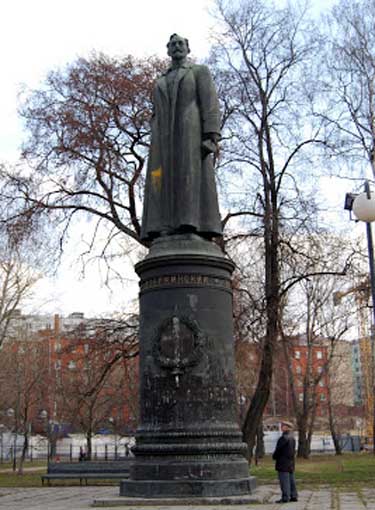Artist:
Yevgeny Vuchetich
Title:
Felix Dzerzhinsky, Iron Felix
Year:
1958
Adress:
Art Muzeon Sculpture Park
www.guyssquared.com:
One of the most famous sculpture is the 15-ton iron monument of Felix Dzerzhinsky that formerly dominated the Lubyanka Square near the KGB headquarters.
Muscovite gave this monument the name 'Iron Felix' because Dzerzhinsky was the first director of the All-Russia Extraordinary Commission to Combat Counter-revolution and Sabotage – the future KGB. In August, 1991 the world saw on TV footage the Russian people crowded Lubyanka Square and the memorial to Dzerzhinsky that was toppled by a cheering crowd with the help of a crane. Demolition of this monument became a symbol of the revolution in modern Russia.
This Park was established after the dissolution of the Soviet Union, in 1992. This place was chosen by Moscow government to bring major Soviet monuments from all over Moscow city. It was decided not to destroy our Soviet past but to preserve it. And many sculptures of Soviet Moscow that were built to glorify Soviet Empire turned up to be placed there in the Sculpture Park. www.russianmyths.wordpress.com:
Dzerzhinsky died of heart failure (probably the results of overexertion) in 1926, and from then until 1990, the large square in front of the Lubyanka bore his name. In 1958, renowned Soviet sculptor Yevgeny Vuchetich unveiled a 15-ton statue of Dzerzhinsky in the center of the square. It was soon after dubbed 'Iron Felix.'
'Felix' sat unmolested for the next 33 years. But on the evening of August 22, 1991, following the attempted communist coup, a crowd of about 10,000 people marched on Lubyanka Square, and with a crane borrowed from the U.S. Embassy, dropped 'Felix' on his face. He was later trucked away to the Graveyard of Lost Monuments, near the Central House of Artists. There he remains in virtual oblivion to this day.
There have already been six proposals since 1999 to return Felix to his proper place, and a poll taken late last year reported that 45% of Russians wanted to see the statue returned to Lubyanka Square. Earlier this month an approximately 50-strong Communist flash mob (no kidding) held a 45 minute demonstration in Lubyanka Square, demanding their hero’s return. They also erected a little 8 ft. high 'Plaster Felix,' (supposedly a gift from the Ukrainian Communist Party), and hoisted signs that read 'Let’s bring back the Knight of the Revolution.'
One of the most famous sculpture is the 15-ton iron monument of Felix Dzerzhinsky that formerly dominated the Lubyanka Square near the KGB headquarters.
Muscovite gave this monument the name 'Iron Felix' because Dzerzhinsky was the first director of the All-Russia Extraordinary Commission to Combat Counter-revolution and Sabotage – the future KGB. In August, 1991 the world saw on TV footage the Russian people crowded Lubyanka Square and the memorial to Dzerzhinsky that was toppled by a cheering crowd with the help of a crane. Demolition of this monument became a symbol of the revolution in modern Russia.
This Park was established after the dissolution of the Soviet Union, in 1992. This place was chosen by Moscow government to bring major Soviet monuments from all over Moscow city. It was decided not to destroy our Soviet past but to preserve it. And many sculptures of Soviet Moscow that were built to glorify Soviet Empire turned up to be placed there in the Sculpture Park. www.russianmyths.wordpress.com:
Dzerzhinsky died of heart failure (probably the results of overexertion) in 1926, and from then until 1990, the large square in front of the Lubyanka bore his name. In 1958, renowned Soviet sculptor Yevgeny Vuchetich unveiled a 15-ton statue of Dzerzhinsky in the center of the square. It was soon after dubbed 'Iron Felix.'
'Felix' sat unmolested for the next 33 years. But on the evening of August 22, 1991, following the attempted communist coup, a crowd of about 10,000 people marched on Lubyanka Square, and with a crane borrowed from the U.S. Embassy, dropped 'Felix' on his face. He was later trucked away to the Graveyard of Lost Monuments, near the Central House of Artists. There he remains in virtual oblivion to this day.
There have already been six proposals since 1999 to return Felix to his proper place, and a poll taken late last year reported that 45% of Russians wanted to see the statue returned to Lubyanka Square. Earlier this month an approximately 50-strong Communist flash mob (no kidding) held a 45 minute demonstration in Lubyanka Square, demanding their hero’s return. They also erected a little 8 ft. high 'Plaster Felix,' (supposedly a gift from the Ukrainian Communist Party), and hoisted signs that read 'Let’s bring back the Knight of the Revolution.'



